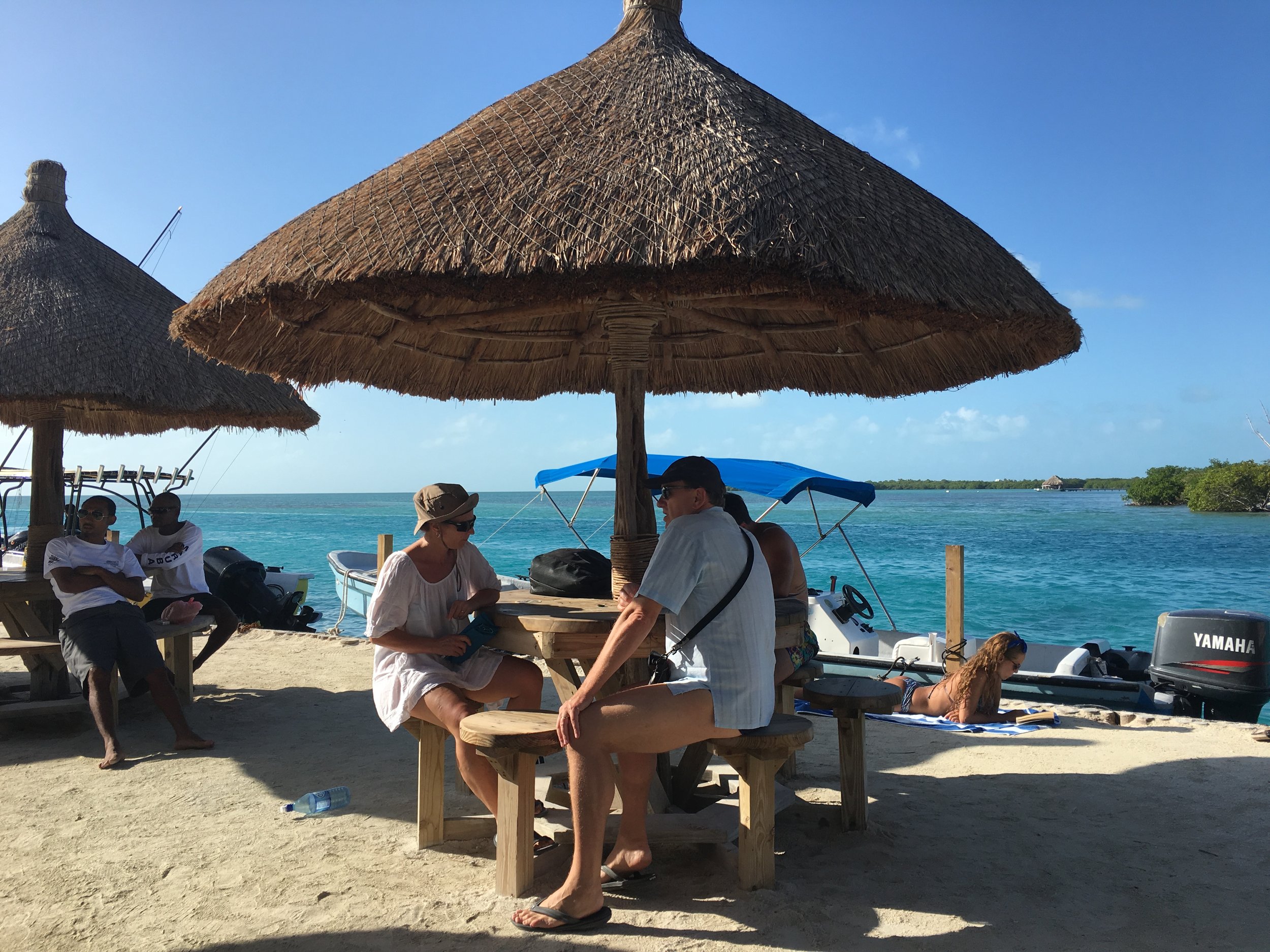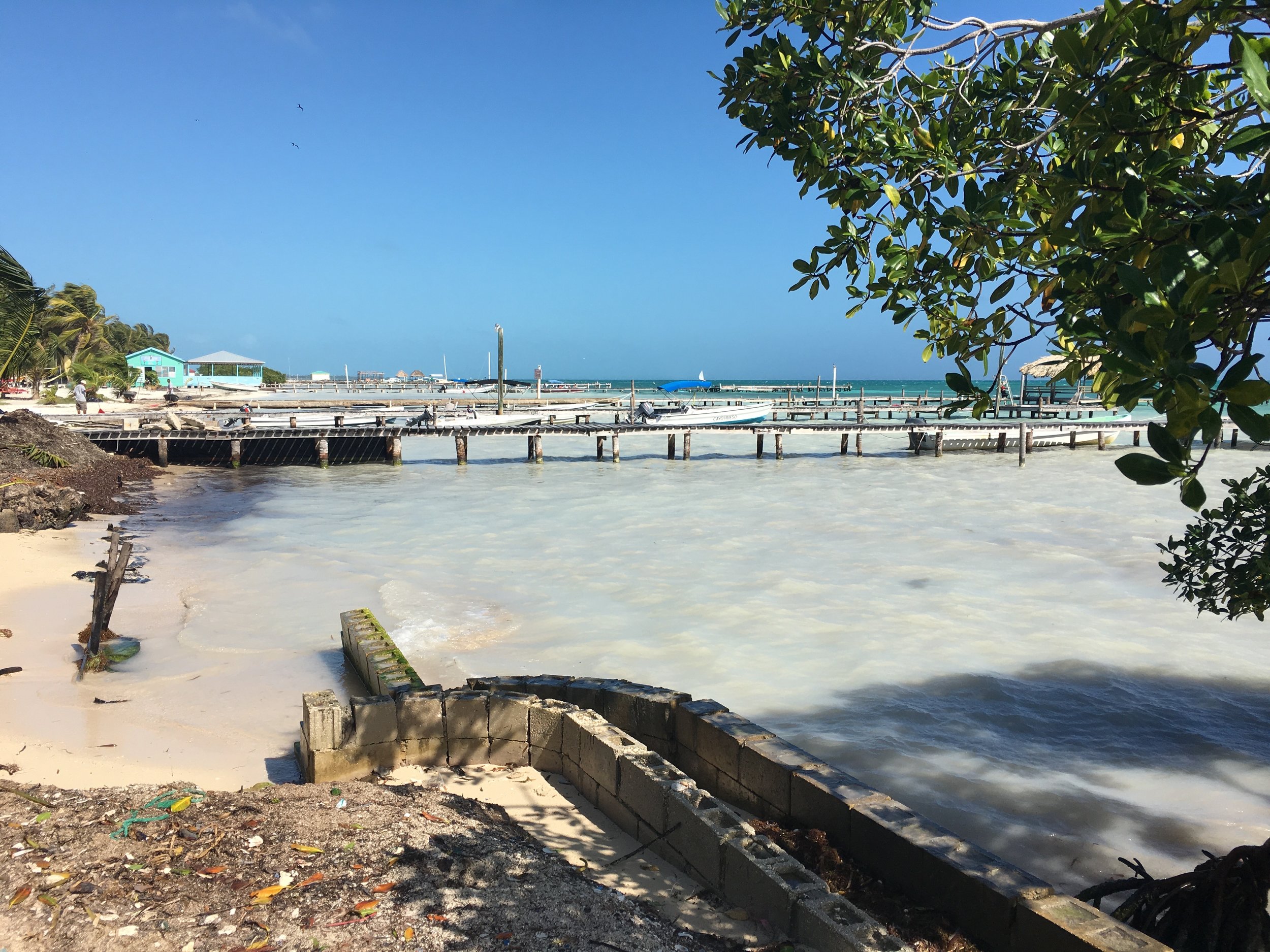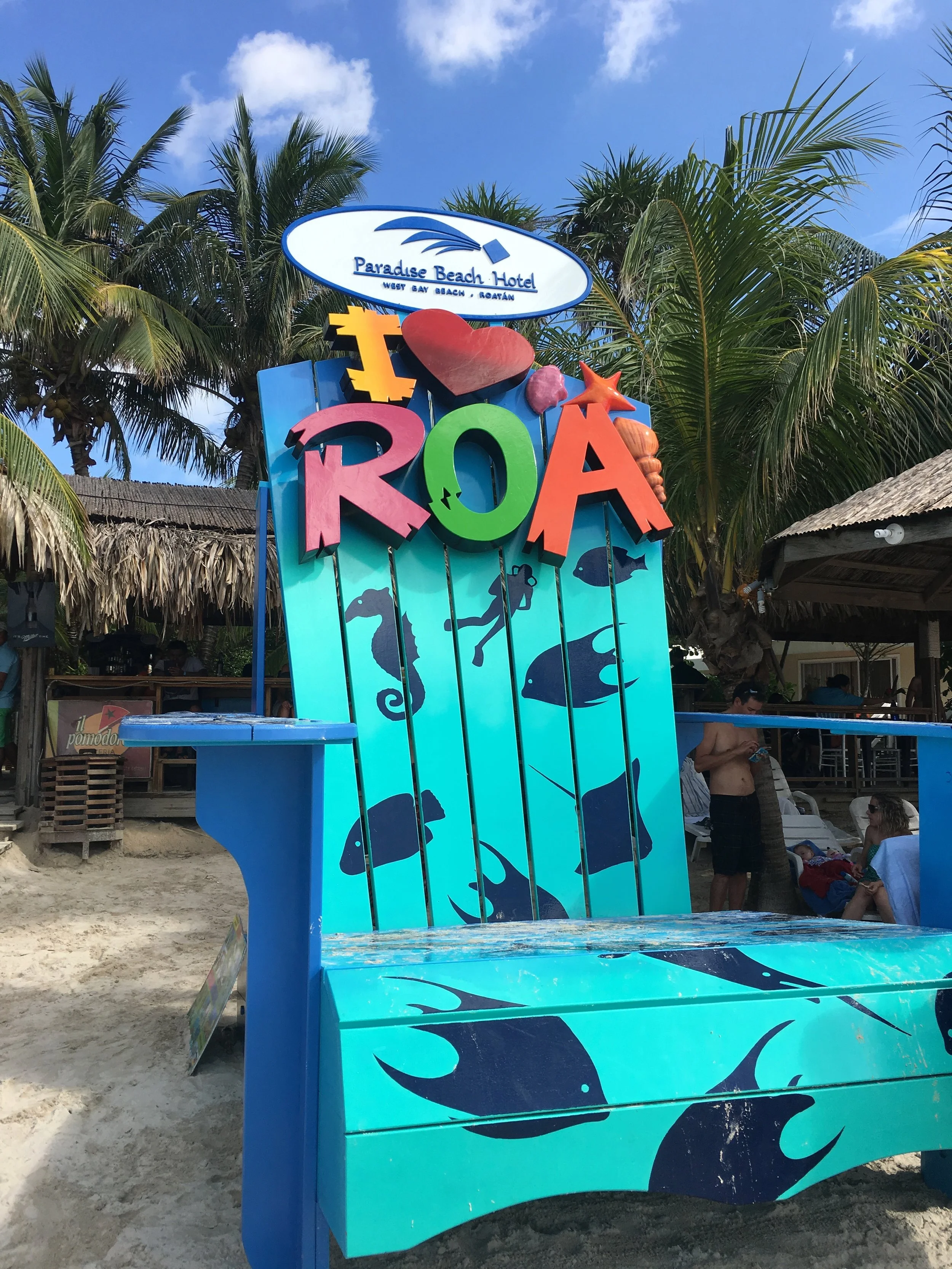Injured In Belize - A Cautionary Tale
This post may contain affiliate links, which means I may receive a commission, at no extra cost to you, if you make a purchase through a link. This helps me keep the Sick Girl Travels blog running while providing you with high-quality product recommendations and great travel deals. Please see my full disclosure for further information. Thanks for your support!
I love Belize. A lot. But it’s the one country that’s tried to kill me on more than one occasion. Still, its blood lust has not diminished my love for the country and its people. And in retrospect, I probably bear a tiny bit of culpability in these near-death experiences. So, please let me regale you with a few cautionary tales so you may avoid making the same painful mistakes I did.
The first thing you should know about Belize is, most people don’t stay on the mainland. The infrastructure isn’t great. Crime is more of an issue, and most people come to see the gorgeous oceanic blue color of the Caribbean and not the crowded streets of Belize City. The mainland does have some incredible destinations, including over 600 Mayan ruins sites. But most of the mainland is a lush tropical rainforest with extreme heat and humidity and apart from the multiple Maya Ruins, (Belize Lamanai) and the copious zip lines (aka murder attempt #2, but more on that later), the real fun is on the islands and atolls in Belize.
Cayes In Belize
Most tourists elect to stay on one of the country’s five most popular Cayes: Ambergris Caye, Caye Caulker, Glover’s Reef, South Water Caye, and Hatchet Caye. Ambergris is the largest and most visited Caye followed by Caye Caulker. The others require a higher level of difficulty and time to reach. That’s not to say that any of the Cayes are particularly easy to reach. Getting there requires either flying in a very tiny puddle jumper or taking a very tiny water taxi or ferry. If you choose to fly, you’ll first touch down in Belize City then catch a Tropic Air flight to the island of your choice.
Whether you choose a boutique hotel or an Airbnb in Belize you can’t go wrong with a relaxing stay on one of these laid-back Cayes.
If flying in a six-seat passenger plane isn’t for you, you could always take a boat. Visitors can take a ferry from Belize City to Caye Caulker or a ferry from Chetumal to Caye Caulker. We opted for the water taxi from Belize City to Caye Caulker. Of course, this trip was not without incident, but more on that later.
Caye Caulker is a sleepy island surrounded by the beautiful oceanic blue color of the Caribbean. Caye Caulker provides access to the second-largest coral reef in the world. For those interested in diving, Caye Caulker should be high on your bucket list. Diving the Blue Hole is the holy grail to most divers. As I am not currently certified to dive, I opted to stay on the island and sip tropical drinks, ride around on a golf cart, enjoy some amazing local food, and enjoy a little Caye Caulker snorkel.
Getting Around Caye Caulker
The motto of Caye Caulker is “go slow.” And with zero paved roads, it’s impossible not to. Caye Caulker is five miles long and easily navigated with a rental cart. There are no cars on the island. Caye Caulker golf cart rentals can be arranged from Buddy’s Golf Cart Rentals, or Go Slow Cart Rental & Taxi Service. If you’re interested in golf cart rentals, Caye Caulker prices range from $12.50 an hour USD for a four-seater to $400/week for a six-seater. During my visit, I was easily able to secure a golf cart rental for a few hours without a reservation.
If you have an issue navigating somewhat bumpy dirt roads, a visit to this island may not be for you. However, if you can get past the bumpy dirt roads, the guides are quite good at helping visitors in and out of boats and golf cart rentals are available a few steps from the dock. If you don’t have mobility issues, I wouldn’t worry about renting a cart. You can easily get around on foot to restaurants in Caye Caulker, beaches, and some of the best Belize snorkeling. Caye Caulker snorkeling is among the best in the world. You can easily explore with your travel companion(s), or sign up for a Caye Caulker snorkeling tour. Just make sure you listen to advisories and don’t venture out on your own.
Many visitors choose to forgo all tours and activities and simply swim by the dock or lounge at the Lazy Lizard Bar, which is right by the water taxi drop-off point. For some great local food, check out nearby Habañero’s, which serves up some of the best seafood in the country. If you stay overnight on the island, be sure to head down to these docks for some breathtaking star gazing.
Not So Fun Facts About Belize
Belize is a wonderful country with beautiful sites and I highly recommend traveling there. However, there are some very real dangers that come with travel to Belize that any tourist must be made aware of.
Accidents - Due to poor road conditions and very rainy conditions, Belize has a higher rate of accidents and traffic fatalities than other Central American countries. Driving is extremely hazardous after dark and during rainstorms.
Busses - Buses frequently operate under poor conditions and lack adequate maintenance. Bus drivers exceed speed limits, pull over without warning for passengers, and pass where it is unsafe to do so, adding to the country’s high traffic fatality rate.
Water Taxi’s - While generally safe, proper maintenance can be an issue as it is with buses. Make sure any boat you board has an adequate amount of life vests. It is not advisable to use water taxis at night due to poor visibility.
Crime - Theft, rape, assault, murder, and other crime rates remain high in Belize. Much of this is centered in the capital of Belize City. Though it is advisable that you stay vigilant and aware of your surroundings at all times, no matter where you are visiting.
Hurricanes - September through October is when tropical storms are most likely to affect Belize. It’s best to avoid visiting during that time period if possible.
Wildlife - Part of what makes Belize so amazing also makes it so dangerous. If you’re near rivers or exploring jungles expect to come in contact with wildlife. Especially crocodiles. Do not approach these animals. Isolated attacks have been reported.
General Safety Concerns - While participating in diving, snorkeling, cave tubing, zip-lining, etc, assume that safety procedures and standards are not up to U.S. standards. I cannot stress this danger enough. I learned about this the hard way. The Overseas Security Advisory Council urges travelers to “carefully consider safety procedures prior to engaging in “at your own risk” activities that can involve long hikes, climbs, and dive sites that are not within cell phone range. Keep portable first aid kits and satellite phones available. Several U.S. citizens died while diving or snorkeling in Belize in 2019; inconsistent and overall lax safety standards may have been a factor in some of these incidents.”
Back to Belize Jungles
After exhausting most of the things to do on Caye Caulker, we caught our tiny water taxi back to the mainland. About 15 minutes out from the island, our boat began to take on water and our guide was quickly trying to remove as much as he could with a plastic cup. Unable to see land at this point, passengers began inquiring about life jackets. Let me just say that the middle of the ocean is a terrible time to start inquiring about life preservers. Turns out we didn’t have enough to go around. It was a nail-biting ride back through the ocean and up the crocodile-infested river, but we made it. Important life lesson, never assume all safety requirements have been met. And don’t be afraid to be “that guy” or “that girl” who annoys the rest of the passengers and crew by asking basic safety questions. Because the moment your guide starts shoveling water out of your craft with a solo cup is a terrible time to start thinking about how you’ll manage to stay afloat.
My Belize Zip Line Accident
After escaping death on the open seas, I felt emboldened enough to take our Jungle Hut Resort up on cave tubing in Belize down a lazy river to look at some Mayan cave drawings. I signed up the night before and went to bed, excited to depart in the morning on a trip that literally promised to be “lazy.”
Cut to the next morning. Overnight the rain forest managed to do what a rain forest does and rained like crazy. The jungle resort called the people at Jaguar Paw Cave Tubing to make sure the caves would be open and not flooded from torrential rains. We were assured the water levels were fine and everything was open. So, we loaded up the van and made the three-hour drive to go caving in Belize.
On our drive to go tubing we passed “The Sleeping Giant.” So named because it looks like a man laying down on his back. Which is what this country does to you, knocks you on your ass.
Upon pulling up to Jaguar Paw Cave Tubing we were greeted with a sign proclaiming the site was closed due to flooding. We were slightly disappointed but largely relieved that we were turned away now and not actually pinned in a flooded cave with no way of escaping. Wanting to salvage our three-hour drive into the jungle, our guide suggested we instead go up the road and enjoy some zip lining. Apparently, Jaguar Paw Belize also operates a jungle zip lining course.
I was in no mood to even attempt a zip line in Belize as Ehlers Danlos Syndrome has basically reduced my body to an uncoordinated sack of meat and loose bones held together by an epidermis that has the fragile look and feel of eyelid skin. But however chronically ill I am is rivaled only by how chronically cheap I am. Since the rest of the tour group insisted that zip lining in Belize would be a suitable replacement for tubing, I was informed we were all going, and zip lining or not, we would not be getting a refund for the day’s excursion. I guess I was going to zipline in Belize.
It’s important to mention I had never been zip lining before. I had no idea how to zip line and I don’t even particularly like heights. After a very quick two-minute talk on zipline safety, they passed me my zip line equipment a helmet, and some gloves, and strapped me in for a trial run. Although incredibly nervous, I reassured myself by looking at the many kids zip lining. If kids under 10 could soar above the jungle canopy, so could I. Right?
This particular line did not have proper brakes. Instead, you had to use your zip lining equipment, aka glove, to grip the metal zip line cable and slow yourself to a stop. I was told by the other zip line enthusiasts in my group who had been to Costa Rica, zip lines usually have a proper brake and don’t rely on your gloved hand to stop. Despite my trepidation, I closed my eyes and jumped. On my first trial run, I gripped a little too hard and came sailing into the platform rather slowly. The guide warned me that I should relax my hand and not grab as hard on the next run, or I may be stuck swinging in the middle of the zip line cable. Got it. I was not about to let that happen.
On line two I was the last person to go. Right before my turn, it started pouring rain. I asked, “is zip lining safe in the rain?” But my guide informed me it would be perfectly safe. I just had to grip as hard as I could when I reached a marker close to the next platform. Got it. Ignore the previous advice and grip hard. I jumped off my platform and whirred over the treetops in the pouring rain, scanning the area around me for my marker, so I knew exactly when to pull down and brake. I saw it and pulled as hard as I could… but nothing happened. I was now racing face first towards a tree as a panicked group of tourists flailed their arms, screaming, “STOP!!! STOP!!!”
I pulled and pulled, but I had complete zipline brake failure. The cable for zipline is metal and becomes slick in the rain. My glove was old and providing zero traction. The next thing I knew, my face was slamming into a metal stopper thrown onto the line in an attempt to stop me. My ankle was smashing into the tree, bending in a way an ankle shouldn’t bend. I came to a stop, but I couldn’t stand. The pain was intense. Fighting through tears, I begged to go down to terra firma, but the guides informed me there were no steps and no ladders down. The only way down was to finish the five zip lines left in the course. I was sobbing. My ankle had quickly blown up like a deformed balloon and my soon-to-be black eye was beginning to take shape. I was completely over zip-lining. Belize was trying to kill me. But the guides kept insisting zip line accidents were rare and sent me down the next line.
Now fighting back tears from the pain and completely paranoid that I would smash into a tree again, I pulled on that zipline cable as though my life depended on it. Of course, by now there was no rain. My paranoid pulling to avoid another zip line accident had caused enough friction to stop immediately. This time I was stopped in the middle of the line, thirty feet above the treetops. Cue my screams of bloody murder. How could I have two zipline accidents in one day?! More importantly, why couldn’t I just be back on the ground?!
One of the guides had to crawl out on the zip line like Spiderman, grab me by my injured ankle, and pull me into the next platform. By now, I was full-on ugly crying and yelling profanities. I was getting stares from the four children under the age of twelve who were miraculously having zero issues with this death trap. This somehow made what happened next all the more unbearable.
I was strapped to one of the guides and forced to finish the course holding on to him for dear life while sobbing with my eyes closed. I made it to the ground where I learned there weren't any hospitals or medical facilities nearby. I couldn’t put weight on my ankle, but luckily, I always travel with an ice pack and an ace bandage, so I at least had that waiting for me after the long, three-hour drive back to the jungle resort.
The next day I flew home, complete with wheelchair service through three airports, and the newfound knowledge that ziplining was not for me. Especially if the braking mechanism is your own hand. Bright side, I became very familiar with what an Airline Accessibility Desk is and how they can help me.
After being examined by doctors at home, I learned I tore multiple ligaments. Years later, my foot and ankle still aren’t the same. I still have pain despite physical therapy, braces, multiple injections, and wearing a boot for several months. Whenever I’m tempted to push myself too far or do something a little too risky, I think of Belize.
Zip Line Disaster - If you think that’s bad, you should see the tree.
If you want to zipline, Belize may not be the best place to try. There are safety precautions and mechanical standards required to zip line. Belize just doesn't have the same safety procedures and standards one might find in the US or other countries. For that reason, I highly recommend avoiding zip lines in Belize. Especially Jaguar Paw. Lest you too become injured in Belize.
I refuse to end my post on a bad note. As I said, I really adore Belize and highly recommend visiting this stunning country. But it is incredibly important to listen to OSAC warnings about safety when traveling.





























